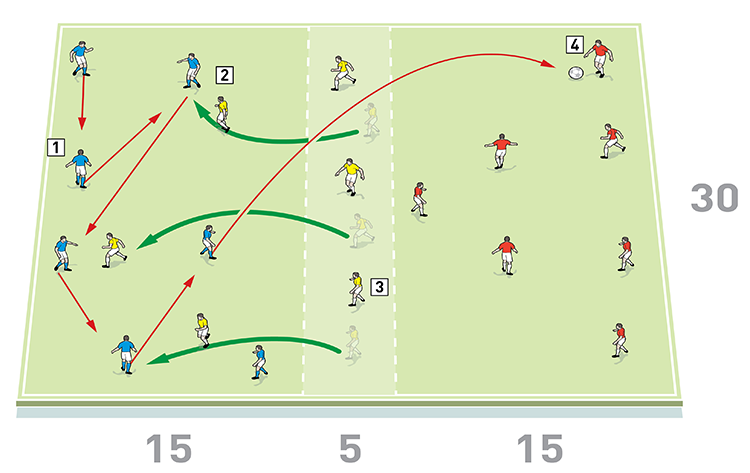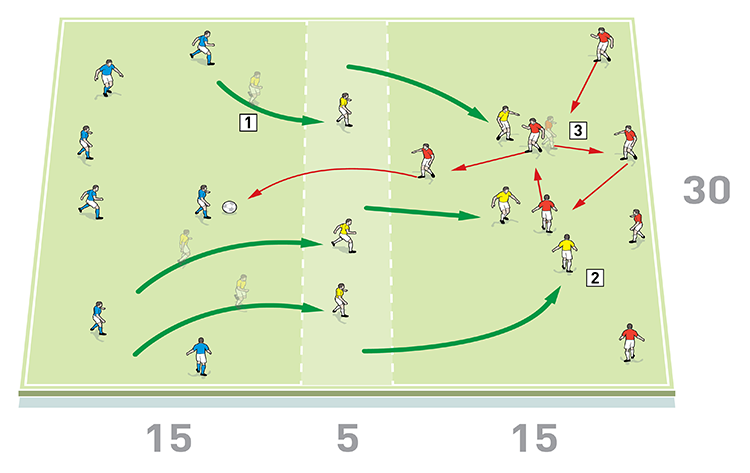You are viewing 1 of your 1 free articles
The purpose of this session is to help us in our preparation for a match day when we’re due to face a high-pressing team who are very effective at putting pressure on the ball. The players benefit greatly from this session because it allows us to play more directly to our front players when the opponents are pressing us high in our own half.
| Area | Up to full pitch |
| Equipment | Balls, bibs, cones, 4 small goals, 2 full-size goals |
| No. of Players | 20 players + 2 goalkeepers |
| Session Time |
Beating a high press: 15mins, Possession games: 25mins, 11v11 game: 20mins |
The purpose of this session is to help us in our preparation for a match day when we’re due to face a high-pressing team who are very effective at putting pressure on the ball. The players benefit greatly from this session because it allows us to play more directly to our front players when the opponents are pressing us high in our own half.
It’s quite important that our defensive players don’t take too many touches and they have an outlet up front that they can play the ball to, allowing our midfielders to get close to the front players when the ball is played forwards.
This session would be delivered in the week leading up to playing against a high-pressing team. We would usually run it two days before a match.
What do I get the players to do?
Beating a high press
We set up a playing area of 35x30 yards, split into two 15-yard end zones and a 5-yard centre zone. We’re using 20 outfield players, divided into two teams of seven (the reds and the blues) and a team of six (the yellows). One team of seven starts in each end zone and the yellow team of six starts in the centre zone.
The blues start with the ball and they must pass to keep possession from the yellows, three of whom enter the end zone to apply pressure, while the remaining three yellows must keep their shape in the centre zone and try to block passing routes to the end zone behind them. The blues must make at least five passes (and no more than 10) before they can pass the ball to the reds in the opposite end zone, as shown [1a].
1a

2. Three of the six yellows enter the end zone to apply pressure and they get a point if they clear the ball out of the area
3. Three of the yellows remain in the centre zone and work as a unit to block passing routes into the zone behind them
4. After completing at least five passes, the blues can pass the ball to the reds in the opposite end zone. They get a point if they succeed
When the ball is passed to the other end zone, the three pressing yellows must retreat back into the centre zone and their three waiting team mates follow the ball into the other end zone and take their turn to press, as shown [1b]. Play now continues in the same manner in the new end zone.
1b

2. The three yellows waiting in the centre zone must follow the ball into the end zone and press
3. The possession team should make the area as big as possible and use short, sharp passes to keep the ball
Each successful pass from one end zone to the other scores a point for the passing team. If the pressing team wins possession, they must clear it out of the area for a point. We play three four-minute games and each team takes one turn to defend, with the team of six selecting one player to join them from the new defending team. The possession team are limited to three-touch and must not play the ball above head height.
What are the key things to look for?
We want to see the possession team making the playing area as big as possible to keep hold of the ball. Off-the-ball movement and effective communication are key to the success of this session.
We also want to see players using short, sharp passing and they should look to penetrate both the high press and the second line of defence in the centre zone by going through them or down the outside of them.
We want to see the defending players get a touch on the ball or force the possession team into making a mistake, with the front three pressers closing down quickly and forcing play down one side and denying the possession team the space to move the ball. We also want to see the pressing players responding to good communication from behind.
The second line of defence in the centre zone should move as a unit in relation to the movement of the ball, in order to shut off passing routes.
What do I get the players to do next?
Possession games
We set up a playing area of 65x40 yards including a five-yard end zone at each end and we position a small goal in each corner. We’re using 20 outfield players split into two teams of seven (the reds and the blues) and a team of six neutrals (the yellows). Two yellows are positioned on each side of the playing area and one is positioned in each end zone.
The reds and the blues play a 7v7 game in the main area, using the help of the yellows who are one-touch and who play for the team in possession. We play six games of three-minutes, with each team playing each other twice (the team of six picks a player to join them from the new neutral team when it’s their turn to play 7v7).
In games 1 and 2, the team in possession must keep the ball and they score points by passing to an end zone player and receiving the ball back – then they must transition and play the ball to the end zone player at the opposite end to secure the point, as shown [2a]. Play then continues in the same manner.
2a

2. The yellows are one-touch and play for the team in possession
3. The team in possession must pass to keep the ball. They score points in games 1 and 2 by passing to an end zone player and receiving the ball back
4. After receiving a return pass from one end player, the possession team must transition and play the ball to the end zone player at the opposite end to secure the point
In games 3 and 4, the possession team scores a point by passing the ball to one end zone player and then transitioning to score in either of the two small goals at the opposite end, as shown [2b]. Play restarts with a ball played into the area by the coach and then continues in the same manner.
2b

2. Here the reds keep possession by making the pitch as large as possible and using sharp combination play to transition from one end to the other
3. In games 3 and 4, the possession team scores a point by passing to one end player and then transitioning to score in either of the two small goals at the opposite end
In games 5 and 6, the team in possession scores a point by passing the ball to one end zone player and then transitioning quickly to pass to the other end zone player, who must play the ball back for the team to score in either of the two small goals at that end of the pitch, as shown [2c]. Play restarts with a ball passed into the area by the coach and then the game continues in the same manner.
2c

2. In games 5 and 6, the possession team scores a point by passing to one end zone player and then transitioning quickly to pass to the other end zone player
3. The second end zone player must then play the ball back for the possession team to score in either of the two small goals at that end to secure the point
What are the key things to look out for?
When in possession, we want to see players making the pitch as big as possible and keeping possession through off-the-ball movement, good supporting runs and effective communication. We also want to see sharp combination play and quick transitions, with players grabbing the opportunity to score goals whenever the opportunity arises.
When out of possession, we want to see players trying to gain possession as quickly as possible. We also want to see teams keeping their defensive shape and denying their opponents the space needed to keep the ball. They should quickly counter-attack on winning possession.
How would I put this into a game situation?
11v11 game
We set up a playing area of 86x60 yards, split into two 37-yard end zones and a 12 -yard centre zone. We position a goal at each end.
We’re using 20 outfield players and two goalkeepers, split into two teams of 11. We play a normal 11v11 game but whenever a team is defending they must always leave three forwards in the centre zone, along with two defenders from the attacking team, as shown [3].
3

2. When a team is attacking they must always press high and leave two defenders in the centre zone
3. Here the blue defending team wins the ball and beats the high press by quickly playing to one of the three forwards they left in the centre zone
4. If the three forwards counter-attack quickly, the blues will have a 3v2 overload on their route to goal
When the defending team wins the ball, they should quickly counter-attack. By leaving the three forwards in the centre zone, the defending team has an outlet to play to and it forces the opposition team using the high press to drop quickly or they will be outnumbered 3v2 when the counter-attacking team breaks. If the three forwards move quickly they will have a 3v2 overload on their route to goal. This makes both teams force play to win the ball, meaning that the team that lost the ball must counter-press quickly or lose out at the back.
We play two games of this with each one lasting ten minutes.
Related Files
Editor's Picks
Using the goalkeeper in build-up play
Pressing principles
Intensive boxes drill with goals
Penetrating the final third
Creating and finishing
My philosophy
Pressing initiation
Compact team movement
Defensive organisation
Coaches' Testimonials

Alan Pardew

Arsène Wenger

Brendan Rodgers

Carlos Carvalhal

José Mourinho

Jürgen Klopp

Pep Guardiola

Roy Hodgson

Sir Alex Ferguson

Steven Gerrard
Coaches' Testimonials

Gerald Kearney, Downtown Las Vegas Soccer Club

Paul Butler, Florida, USA

Rick Shields, Springboro, USA

Tony Green, Pierrefonds Titans, Quebec, Canada
Join the world's leading coaches and managers and discover for yourself one of the best kept secrets in coaching. No other training tool on the planet is written or read by the calibre of names you’ll find in Elite Soccer.
In a recent survey 92% of subscribers said Elite Soccer makes them more confident, 89% said it makes them a more effective coach and 91% said it makes them more inspired.
Get Monthly Inspiration
All the latest techniques and approaches
Since 2010 Elite Soccer has given subscribers exclusive insight into the training ground practices of the world’s best coaches. Published in partnership with the League Managers Association we have unparalleled access to the leading lights in the English leagues, as well as a host of international managers.
Elite Soccer exclusively features sessions written by the coaches themselves. There are no observed sessions and no sessions “in the style of”, just first-hand advice delivered direct to you from the coach.









